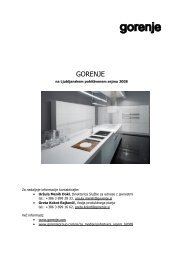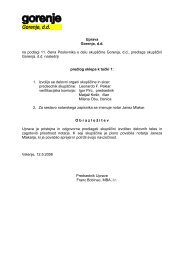Annual Report Gorenje Group 2009
Annual Report Gorenje Group 2009
Annual Report Gorenje Group 2009
Create successful ePaper yourself
Turn your PDF publications into a flip-book with our unique Google optimized e-Paper software.
i) Impairment<br />
(i) Financial assets (including receivables)<br />
A financial asset not carried at fair value through profit or loss is impaired if objective evidence<br />
indicates that a loss event has occurred after the initial recognition of the asset, and that the loss event<br />
had a negative effect on the estimated future cash flows of that asset that can be estimated reliably.<br />
Objective evidence that financial assets (including equity securities) are impaired can include default or<br />
delinquency by a debtor, restructuring of an amount due to the Company on terms that the Company<br />
would not consider otherwise, indications that a debtor or issuer will enter bankruptcy, the<br />
disappearance of an active market for a security. In addition, for an investment in an equity security, a<br />
significant or prolonged decline in its fair value below its cost is objective evidence of impairment. The<br />
Company considers evidence of impairment for receivables and held-to-maturity investment securities<br />
at both a specific asset and collective level. All individually significant receivables and held-to-maturity<br />
investment securities are assessed for specific impairment. All individually significant receivables and<br />
held-to-maturity investment securities found not to be specifically impaired are then collectively<br />
assessed for any impairment that has been incurred but not yet identified. Receivables and held-tomaturity<br />
investment securities that are not individually significant are collectively assessed for<br />
impairment by grouping together receivables and held-to-maturity investment securities with similar risk<br />
characteristics.<br />
In assessing collective impairment the Company uses historical trends of the probability of default,<br />
timing of recoveries and the amount of loss incurred, adjusted for management's judgement as to<br />
whether current economic and credit conditions are such that the actual losses are likely to be greater<br />
or less than suggested by historical trends.<br />
An impairment loss in respect of a financial asset measured at amortised cost is calculated as the<br />
difference between its carrying amount and the present value of the estimated future cash flows<br />
discounted at the asset's original effective interest rate. Losses are recognised in profit or loss and<br />
reflected in an allowance account against receivables. Interest on the impaired asset continues to be<br />
recognised through the unwinding of the discount. When a subsequent event causes the amount of<br />
impairment loss to decrease, the decrease in impairment loss is reversed through profit or loss.<br />
Impairment losses on available-for-sale investment securities are recognised by transferring the<br />
cumulative loss that has been recognised in other comprehensive income, and presented in the fair<br />
value reserve in equity, to profit or loss. The cumulative loss that is removed from other comprehensive<br />
income and recognised in profit or loss is the difference between the acquisition cost, net of any<br />
principal repayment and amortisation, and the current fair value, less any impairment loss previously<br />
recognised in profit or loss. Changes in impairment provisions attributable to time value are reflected as<br />
a component of interest income.<br />
Impairment losses on receivables are recognised in accordance with the item by item principle where<br />
bankruptcy procedures or compulsory compositions have been initiated, or on the basis of disputability<br />
or doubtfulness of receivables.<br />
(ii) Non-financial assets<br />
The carrying amounts of the Company's non-financial assets, other than investment property,<br />
inventories and deferred tax assets, are reviewed at each reporting date to determine whether there is<br />
any indication of impairment. If any such indication exists, then the asset's recoverable amount is<br />
estimated. For goodwill, and intangible assets that have indefinite useful lives or that are not yet<br />
available for use, the recoverable amount is estimated each year at the reporting date.<br />
182<br />
<strong>Annual</strong> <strong>Report</strong> <strong>Gorenje</strong> <strong>Group</strong> <strong>2009</strong>

















